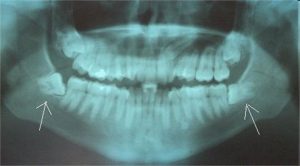Get Ready for Your Wisdom Teeth Surgery
Wisdom teeth removal is a common dental procedure, and understanding the wisdom teeth removal procedure can help alleviate any concerns you may have. Our Fort Erie and Ridgeway dentists want to ensure you’re prepared.
At Inigo Dentistry and Bertie Dental Office, we build relationships through trust, empathy, and clear communication. Our doctors explain all treatment options and costs upfront so you can make informed decisions.
To schedule an appointment, contact us today by calling 905-871-2903 for our Fort Erie, ON, dental clinic and 905-894-5555 for our Ridgeway dental office.
Why Wisdom Teeth Often Need to be Removed
Preventing complications such as impaction, infection, and damage to adjacent teeth is the primary reason why wisdom teeth removal is crucial for oral health. Impacted wisdom teeth can lead to gum disease, tooth decay, and even the formation of cysts or tumors. Wisdom tooth removal is a surgical procedure performed by a dentist or oral surgeon, ensuring the safe and thorough extraction of the troublesome tooth.
Of course, every procedure comes with potential risks and complications. Wisdom tooth removal may involve:
- Pain
- Swelling
- Infection
- Nerve damage
- Dry socket

Assessing Your Wisdom Teeth
Oral Examination
During an oral examination, our dentists will conduct a comprehensive dental examination to assess the positioning and state of the wisdom teeth, the surrounding gum tissue, and nearby teeth. This evaluation helps predict if your wisdom teeth need an extraction or if they’ll cause any current or future potential issues. Patients are typically evaluated in their mid-teen years to determine how many wisdom teeth they have and if they require extraction.
X-Ray Analysis
Identifying impacted wisdom teeth and any associated issues is made possible through dental X-rays. Panoramic, periapical, and occlusal X-rays are utilized for the assessment of wisdom teeth, including the detection of impacted wisdom teeth. The advantages of X-rays include:
- Pinpointing the exact location and size of the wisdom teeth
- Identifying any associated issues, such as cysts or tumors
- Assisting the dentist in creating the most suitable plan of action for the removal of wisdom teeth
- Ensuring a successful extraction and minimizing potential complications
Personalized Treatment Plan
Based on your specific case, a personalized treatment plan is developed. We’ll make a plan based on a comprehensive diagnosis, including dental X-rays, and consider factors such as the risk of blood clot formation during the extraction process.
Anesthesia Options for Wisdom Teeth Removal
At our dental offices, we offer nitrous oxide and IV (intravenous) sedation for your comfort. With nitrous oxide, patients are awake but feel a calming and comforting effect. You’re in total control and able to communicate with the dentists.
With IV sedation, you’ll be relaxed and have little to no memory of the procedure. We’ll discuss your options and which is best suited for you at your initial wisdom teeth consultation.
The Wisdom Teeth Extraction Process
Anesthesia Administration
The first step in your extraction is anesthesia administration, which guarantees your comfort and assists with pain management. Regardless of the type of anesthesia chosen, it’s essential to follow your dentist’s instructions and take necessary precautions before the procedure, such as avoiding food and beverages (except for prescription medications taken with a sip of water) for at least 6 hours before the extraction.
Tooth Extraction
During the tooth extraction procedure, an incision is first made in the gum tissue, revealing both the tooth and the underlying bone. If any bone is obstructing access to the tooth root, it’s carefully removed. To facilitate a smoother extraction, the wisdom tooth might be sectioned into smaller pieces.
Once adequately sectioned, the tooth is extracted from its position. Following the removal, the site is meticulously cleaned to rid it of any debris. In some cases, to aid the healing process, the wound is sutured, although these stitches typically dissolve over some time.
Suturing and Gauze Placement
Suturing and gauze placement after the extraction aid in controlling bleeding and promoting healing. Our dentist may use dissolvable sutures that disappear within 3 to 5 days, eliminating the need for removal.
A gauze is placed over the extraction site to absorb blood and help form a clot, which is essential for the healing process. Following your dentist’s post-operative instructions, including guidelines for pain management, swelling reduction, and oral hygiene, will ensure a smooth recovery and minimize potential complications.

Frequently Asked Questions
Is the wisdom tooth removal process painful?
Wisdom tooth removal is generally quick and painless, as the area will be numbed before the procedure begins. You may feel slight pressure and tugging during the extraction, but you should not experience any pain. After the procedure, some tenderness and swelling can occur near the extraction site, however, this should subside within 7 days with some rest and recuperation.
How long does a wisdom teeth procedure usually take?
Wisdom tooth extraction typically takes between 45 minutes and 2 hours, with the average procedure lasting around an hour. Single teeth may take less time to remove, while difficult cases and those involving all four teeth could take longer.
Schedule Your Wisdom Tooth Removal Today!
Wisdom teeth removal is a common dental procedure designed to prevent complications and promote overall oral health. If you need your wisdom teeth removed, contact us today by calling 905-871-2903 for our Fort Erie, ON, dental clinic and 905-894-5555 for our Ridgeway office.
